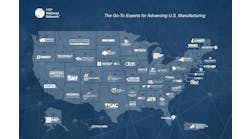Manufacturing's Pushmi-Pullyu: Legislation on One End, Taxes and Regulation on the Other
Open up a newspaper or turn on the evening news and chances are you will see a story on another new effort promoting U.S. manufacturing.
Don't get me wrong, I'm glad to see manufacturing finally get its share of the national spotlight – all the stories written, speeches given and legislation introduced help underscore the importance of a strong manufacturing sector to economic growth, job creation and national security.
But are all of the efforts really getting to the root of the challenges we face as an industry and a nation?
I'm reminded of Dr. Doolittle's menagerie and the "pushmi-pullyu," a gazelle/unicorn cross that had two heads on opposite ends of its body, so when it would try to move forward, the heads would move in opposite directions.
It's also an unfortunate metaphor for the relationship between manufacturing and the U.S. government: While legislation, policy and initiatives have come forth with the aim of pushing the industry forward, a snarled web of tax and regulation lies underneath and hinders any movement toward real progress.
For example, I was happy to see it when a group of 22 Democrat U.S. Senators recently introduced the Manufacturing Jobs for America initiative. The package of 40 bills, many with bipartisan support, aims to strengthen the workforce; open markets abroad; expand access to capital; and otherwise create favorable conditions necessary for growth.
These are all laudable goals, and AMT commended the leadership of the Senators introducing the package and gave a statement of support backing the effort.
However, one major problem that the initiative does not address is the burdensome regulatory environment faced by U.S. manufacturers.
MAPI recently released 10 facts about manufacturing and regulation, which revealed that since 1981, there has been an average of about 1.5 manufacturing-related regulations issued each week – more than 2,300 total! These regulations will cost industry $500 billion in shipments in 2013 alone.
How can Congress expect to increase manufacturing jobs for America when it is virtually ignoring one of the most serious impediments to our progress?
Tax and Budget Policy
Tax and budget policy, and the uncertainty surrounding it, is another significant barrier to U.S. manufacturing competitiveness. The October government shutdown and debt ceiling debacle are just the latest examples.
In recent years, the Administration and Congress have been governing from one fiscal crisis to the next, refusing to work together on even the most pressing issues of the day.
These stopgap measures hurt not just the manufacturing sector, but the entire nation, and the American people. Yet, it seems lawmakers have learned nothing from past few weeks of voter outrage, as they try to assuage expectations of any grand budget bargain or serious tax reform in the coming weeks. No amount of pro-manufacturing legislation is going to replace that.
The chaotic environment in Washington creates real risk for the future of our industry.
Right now, we're in a "sweet spot" for manufacturing in this country. The convergence of lower energy costs here along with rising labor costs overseas has led many manufacturers – including those that are internationally based – to move or increase production in the U.S. They want to be closer to their customer base and remove much of the length – and risk – from their supply chains.
Imagine the possibilities with a more favorable tax and regulatory environment that increased the competitiveness of the companies.
AMT's Manufacturing Mandate spells out what we believe is needed for a strong U.S. manufacturing industry. It begins with a clear, focused approach to manufacturing policy – one that prioritizes and coordinates efforts and funding across agencies. AMT successfully works with many government agencies on behalf of our members, including NIST and NSF on innovation and technology issues, Department of Labor on smartforce development, and Department of Commerce on improving market access.
However, a coordinated, cohesive strategy at the highest level of government is sorely lacking. Money is wasted and time lost with duplicative and outdated programs. There are countless manufacturing programs and services available but no "one-stop-shop" to see what they are about.
Next we need to increase our global competitiveness by addressing our most immediate challenges — restoring certainty through tax, spending and regulatory reforms is at the top of the list. I want to be clear that I am not advocating for no taxes, no spending or no regulations. What I am advocating for is consistent tax, spending and regulatory policies that improve the business environment and level the playing field for U.S. manufacturers worldwide.
Then comes the icing on the cake – initiatives to increase innovation; improve access to capital, build a 21st century smartforce, etc. The Obama Administration and Congress are expressing a genuine interest in helping our industry grow, create jobs and help build our economy. But it's imperative to first look at the existing policies that are holding us back to make sure all of those efforts aren't made in vain.
If the government is truly dedicated to ensuring that the U.S. has the strongest possible manufacturing industry, they must truly get to the root of the problem. Legislation to boost the industry is certainly a welcome step, but the first line of action must be addressing our immediate budget issues and lessening the underlying tax and regulatory burden. Without that, we are only getting pushed in one direction and pulled in another, with no forward progress toward our end goals.
Douglas Woods is president of AMT – The Association for Manufacturing Technology.




